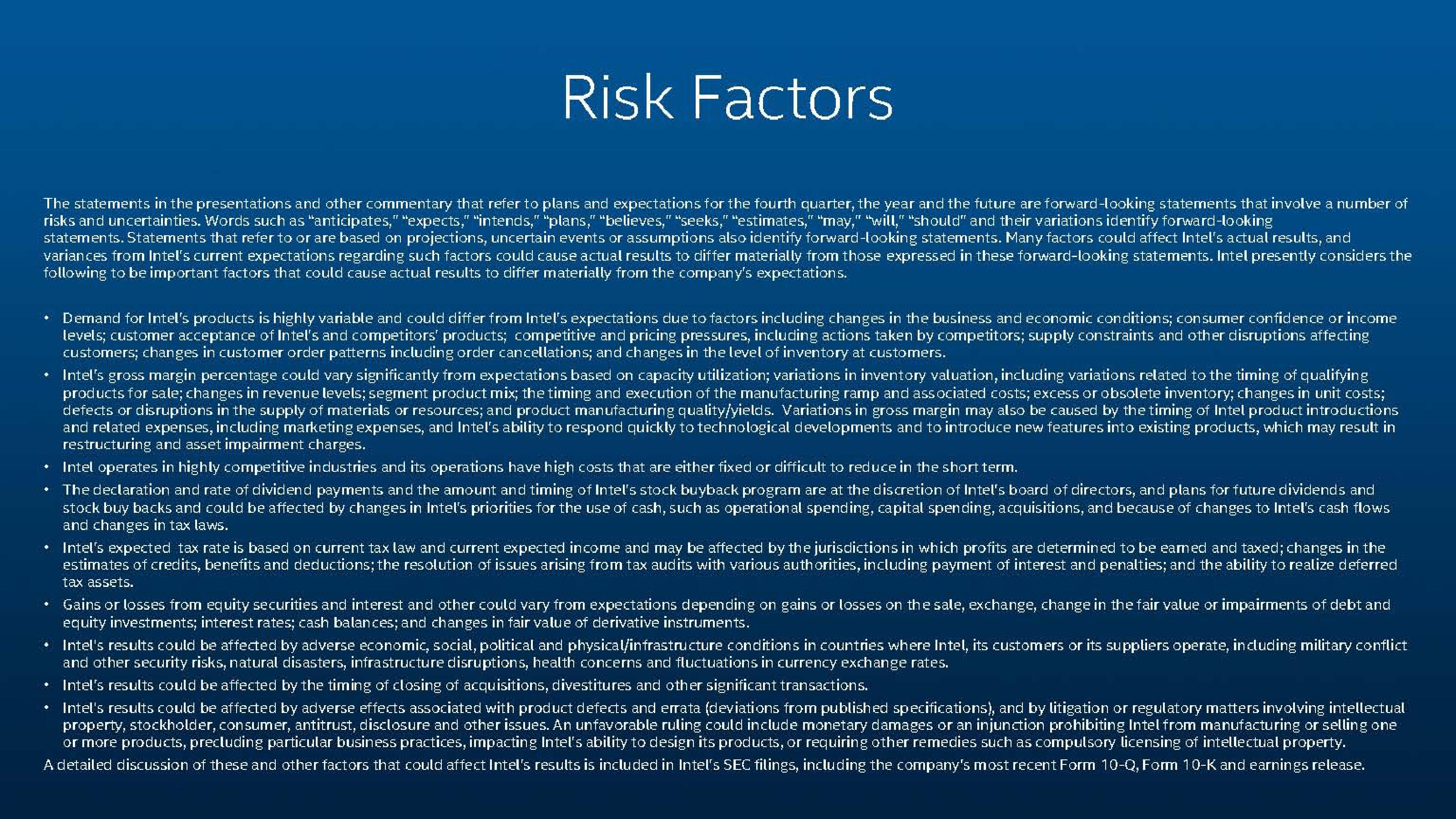Intel Investor Meeting 2014
Risk Factors
The statements in the presentations and other commentary that refer to plans and expectations for the fourth quarter, the year and the future are forward-looking statements that involve a number of
risks and uncertainties. Words such as "anticipates," "expects," "intends," "plans," "believes," "seeks," "estimates," "may," "will," "should" and their variations identify forward-looking
statements. Statements that refer to or are based on projections, uncertain events or assumptions also identify forward-looking statements. Many factors could affect Intel's actual results, and
variances from Intel's current expectations regarding such factors could cause actual results to differ materially from those expressed in these forward-looking statements. Intel presently considers the
following to be important factors that could cause actual results to differ materially from the company's expectations.
+
+
+
Demand for Intel's products is highly variable and could differ from Intel's expectations due to factors including changes in the business and economic conditions; consumer confidence or income
levels; customer acceptance of Intel's and competitors' products; competitive and pricing pressures, including actions taken by competitors; supply constraints and other disruptions affecting
customers; changes in customer order patterns including order cancellations; and changes in the level of inventory at customers.
+
Intel's gross margin percentage could vary significantly from expectations based on capacity utilization; variations in inventory valuation, including variations related to the timing of qualifying
products for sale; changes in revenue levels; segment product mix; the timing and execution of the manufacturing ramp and associated costs; excess or obsolete inventory; changes in unit costs;
defects or disruptions in the supply of materials or resources; and product manufacturing quality/yields. Variations in gross margin may also be caused by the timing of Intel product introductions
and related expenses, including marketing expenses, and Intel's ability to respond quickly to technological developments and to introduce new features into existing products, which may result in
restructuring and asset impairment charges.
Intel operates in highly competitive industries and its operations have high costs that are either fixed or difficult to reduce in the short term.
The declaration and rate of dividend payments and the amount and timing of Intel's stock buyback program are at the discretion of Intel's board of directors, and plans for future dividends and
stock buy backs and could be affected by changes in Intel's priorities for the use of cash, such as operational spending, capital spending, acquisitions, and because of changes to Intel's cash flows
and changes in tax laws.
Intel's expected tax rate is based on current tax law and current expected income and may be affected by the jurisdictions in which profits are determined to be eamed and taxed; changes in the
estimates of credits, benefits and deductions; the resolution of issues arising from tax audits with various authorities, including payment of interest and penalties; and the ability to realize deferred
tax assets.
Gains or losses from equity securities and interest and other could vary from expectations depending on gains or losses on the sale, exchange, change in the fair value or impairments of debt and
equity investments; interest rates; cash balances; and changes in fair value of derivative instruments.
Intel's results could be affected by adverse economic, social, political and physical/infrastructure conditions in countries where Intel, its customers or its suppliers operate, including military conflict
and other security risks, natural disasters, infrastructure disruptions, health concerns and fluctuations in currency exchange rates.
Intel's results could be affected by the timing of closing of acquisitions, divestitures and other significant transactions.
Intel's results could be affected by adverse effects associated with product defects and errata (deviations from published specifications), and by litigation or regulatory matters involving intellectual
property, stockholder, consumer, antitrust, disclosure and other issues. An unfavorable ruling could include monetary damages or an injunction prohibiting Intel from manufacturing or selling one
or more products, precluding particular business practices, impacting Intel's ability to design its products, or requiring other remedies such as compulsory licensing of intellectual property.
A detailed discussion of these and other factors that could affect Intel's results is included in Intel's SEC filings, including the company's most recent Form 10-Q, Form 10-K and earnings release.View entire presentation